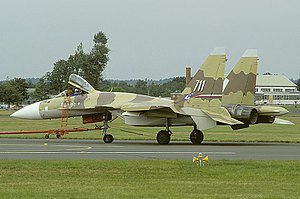Sukhoi Su-37
| Sukhoi Su-37 | |
|---|---|
 Su-37 at Farnborough, 1996 |
|
| Type: | Air superiority fighter |
| Design country: | |
| Manufacturer: | |
| First flight: |
April 2, 1996 |
| Commissioning: |
Never put into service |
| Production time: |
Was never mass-produced |
| Number of pieces: |
1 |
The Sukhoi Su-37 ( Russian Сухой Су-37 , NATO code name : Flanker-F ) is a single-seat multi - role fighter of the Su-27 family developed in Russia . The Su-37, also known as the "Terminator", together with the Su-35BM, which has been produced since 2009, is the most powerful variant of the family.
development
The Su-37 is a further development of the Su-35 , which was originally called the Su-27M. Development of the Su-27M began in the early 1980s; the first prototype (T-10S-70) made its maiden flight in 1988. The primary changes compared to the Su-27P were the canards (duck wings), more powerful engines, a new radar and a fly-by-wire flight control. In later prototypes, the cockpit was completely revised again. In 1993 the Su-27M was renamed the Su-35.
Compared to the Su-35, a 2D thrust vector control has been added to the Su-37 . The test flights of the Su-37 began in April 1996. The Su-37 was presented in 1996 at the Farnborough Airshow by Sukhoi test pilot Yevgeny Frolov. The Kulbit aerobatic figure was presented to the public for the first time .
construction
The Su-37 is an all-weather single-seat fighter aircraft with secondary fighter-bomber capabilities. The machine is sometimes because of their canards as well as the conventional design of height and vertical tail called a triplane. The Su-37 contains several updates including the new multifunction pulse Doppler radar NO-11M with passive electronic beam steering . Among other things, it has an advanced terrain tracking mode and can pursue and combat up to 15 targets at the same time. In addition, it has a backward- looking search radar NO-12 with limited performance. The Su-35 contains more composite materials than the Su-27. The increased thrust and the thrust vector control were implemented with the AL-37FU engines. The variably controllable nozzles of the Su-37 can be moved 15 ° up and down, which significantly improves their rolling ability .
Present and Future
The only built Su-37 with the number 711 crashed in 2002 after an engine failure. Since the summer of 2000 she had been upgraded to a Su-35 and the thrust vector control dismantled.
technology
Technical specifications
| Parameter | Data |
|---|---|
| crew | 1 |
| length | 22.18 m |
| span | 14.70 m |
| Wing area | 62.04 m² |
| Wing extension | 3.48 |
| Wing loading |
|
| height | 6.43 m |
| Empty mass | 18,400 kg |
| normal takeoff mass | 26,700 kg |
| Max. Takeoff mass | 34,000 kg |
| Fuel capacity | approx. 7,500 kg (internal) |
| Fuel ratio | 0.29 |
| g limits | −3 / + 9 g |
| Top speed |
|
| Service ceiling | 18,800 m |
| Rate of climb | 330 m / s |
| Range | 3,680 km |
| Engines | two Saturn / Ljulka-AL-37FU - turbofan engines |
| Thrust |
|
| Thrust-to-weight ratio |
|
Armament
- a 30-mm automatic cannon Grjasew-Schipunow GSch-301 (9A-4071K) with 150 rounds combat charge
- Gun loading of a maximum of 8200 kg at 14 external load stations
Web links
- airpower.at: Overview of the Su-27 family
- Air Force Technology
- Article about the Su-27 with a section about the Su-37 ( Memento from December 20, 2002 in the Internet Archive )